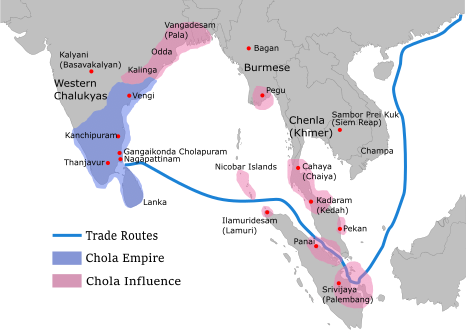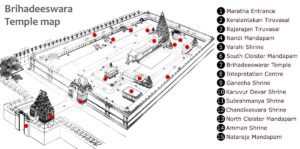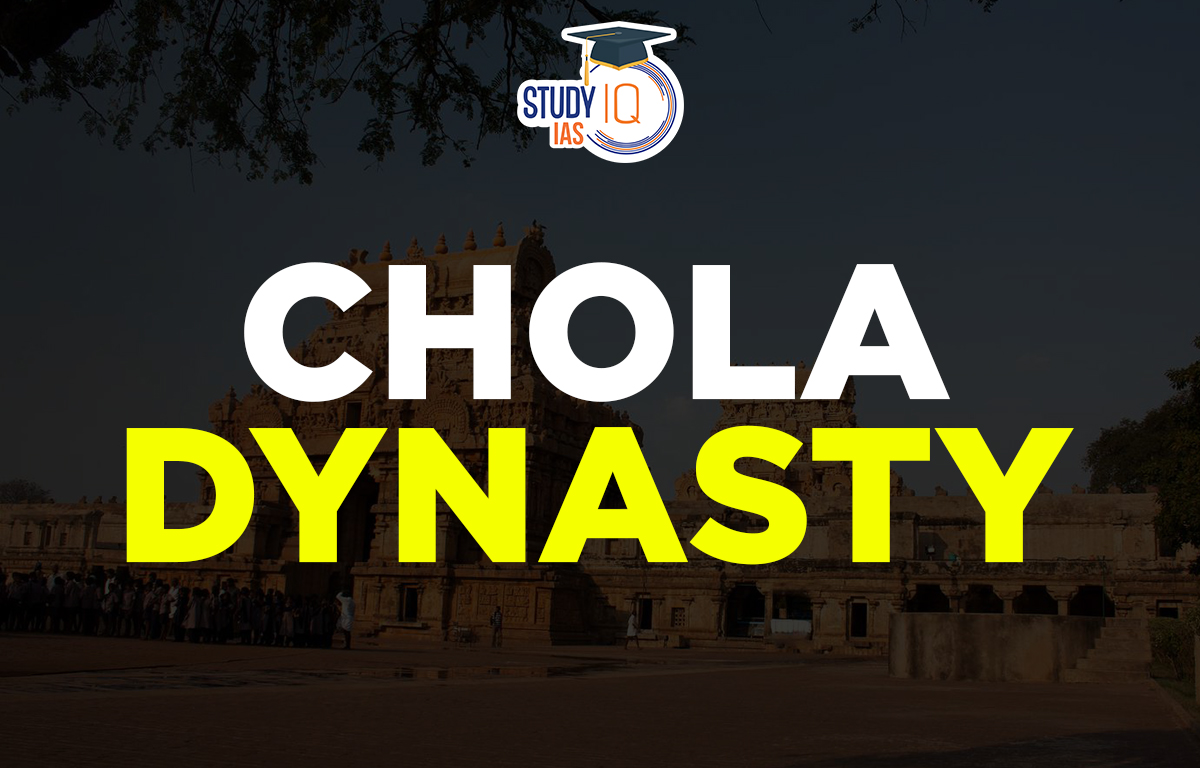Table of Contents
Chola Dynasty
Southern India region was ruled by the Tamil-speaking Chola dynasty. They have been in power for one of history’s longest periods. The Sangam Age is where the Chola dynasty is first mentioned. The Kaveri River Valley served as the Chola kingdom’s heartland. For the study of Chola history, the primary materials consist of more than 10,000 inscriptions carved into copper and stone. During this time, literary works like Tamil literature were in great demand.
The increase in bhakti saints and hymn collections reflects the societal characteristics of the time. This era is represented by the great epics Muvarula and Kamba Ramayanam. The Chola Dynasty can naturally be divided into four periods,
- Early Chola of Sangam Literature
- The interregnum between the fall of Sangam Chola & rise of Medieval Cholas under Vijayalaya.
- Dynasty of Vijayalaya
- Chalukya Chola Dynasty of Kulothunga Chola I
Read about: Indus Valley Civilization
Chola Dynasty Map
The Chola dynasty expanded its territory through military conquests and strategic alliances. They launched successful naval expeditions and established control over the Bay of Bengal and the Sri Lankan island.

Read More: List of the Mughal Emperors
Chola Dynasty as Region of Power
The Current existing Tamil Nadu, Kerala, and portions of Andhra Pradesh and Karnataka made up the Chola kingdom. This is one such dynasty which has the longest reigns in recorded history.
Chola Dynasty Geographical Extent
The lush Kaveri River Valley served as the Cholas’ home base. South of the Tungabhadra, they united peninsular India and controlled it as one state for three centuries. The southernmost point of the Chola holdings was the Maldives, and the northernmost point was the banks of the Godavari River in Andhra Pradesh.
Chola Dynasty Capital and Significant Locations
Thanjavur was the early capital of Cholas, followed by Gangaikonda Cholapuram. Madurai and Kanchipuram were the regional capitals where proceedings of the sporadic court took place.
Read about: Decline of Mughal Empire
Chola Dynasty Founder
Vijaylaya was the monarch who was called a “feudatory,” started the Chola dynasty. Among the giants in the area, Vijaylaya was a relatively minor figure, but he set the stage for a dynasty that would eventually come to rule a sizable portion of southern India.
Rajaraja I and his successors Rajendra I, Rajadhiraja I, Rajendra II, Virarajendra, and Kulothunga Chola I led the Rajaraja I dynasty to dominance as a political, military, and cultural powerhouse.
Contemporaries
The dynasty remained in power up to the 13th century CE, when it was joined by the Chera and Pandya as one of the Three Crowned Kings of Tamilakam. During the Chola period, other powerful kingdoms in the region would also come and go (about the 9th to 12th century AD).
- Rashtrakutas of the Deccan
- Chalukyas of the Andhra Pradesh
Read More: Battle of Buxar
Chola Dynasty Rulers/Kings
One of the longest dominating dynasties in southern India’s history, the Cholas ruled from the eighth through the twelfth centuries AD. The Cholas’ rule started in the ninth century after Pallas was overthrown by them.
During the mediaeval age, the Cholas attained a level of dominance and growth never before seen. During this period, kings like Aditya I and Parantaka I ruled. Beyond this point, Rajaraj and Rajendra Chola continued to expand their dominion into the Tamil region. This splendour continued until the early 13th-century arrival of the Pandyas. Some of the Important rulers of the Chola Dynasty are discussed as follows:
| Rulers | Details |
| Vijayalya | The Pallavas’ initial feudatory and the founder of the Imperial Cholas. In 815 CE, he conquered Tanjore from the Muttaraiyars and constructed a Durga shrine. |
| Aditya | He strengthened the empire and was the son of Vijyalaya. By conquering Aparajita and taking control of Tondaimandalam, he put a stop to the Pallava kingdom. |
| Parantaka I (907-955) | Parnataka I, the son of Aditya, expanded the Chola empire. Rajasimha II of the Pandyas was defeated, and he took control of Madurai under the name Maduraikonda (captor of Madurai). The famous temple builder Parantaka I.
He also added a golden roof to the Vimana of Chidambaram’s well-known Nataraja temple. However, the Rashtrakuta monarch Krishna III defeated him at the well-known battle of Tokkolam in 949 CE. |
| Parantaka II | Beginning with Parantaka II’s rule, the Chola dynasty’s authority surged once more when he reclaimed Todamandalam and restored the dynasty’s supremacy |
| Rajaraja I(985-1014 CE) | Rajaraja Chola I’s accession to the throne in 985 CE marked the beginning of the Chola empire’s dominance. Under his leadership, the Chola monarchy expanded into a vast, cohesive, and well-organized empire with a potent standing army and navy. He adopted several names, including “Mummidi Chola,” “Jayankond,” and “Sivapadasekara.”
In the Battle of Kandalur Salai, he vanquished the Chera king Bhaskararaviraman. He overthrew Amarabhujanga, the Pandya nation’s ruler, and imposed Chola dominion over it. He took control of the Mysore region’s Gangavadi, Tadigaipadi, and Nolambapadi. As Sri Lanka’s monarch Mahindra V fled his nation, he invaded and seized the country’s northern region. The Kalyani Western Chalukyas were defeated by the Cholas. Rajaraja I conquered Satyasraya and took control of Raichur Doab, Banavasi, and other locations. By defeating the Telugu Chodas, he returned the Vengi throne to its kings Saktivarman and Vimaladituya. Kundavai was married to Vimaladitya by Rajaraja. Rajaraja’s naval expedition against the Maldives Islands, which resulted in their conquest, was his final military success. He was an ardent adherent of Saivism. In 1010 CE, he finished building Tanjore’s well-known Rajarajeswara or Brihadeshwara temple. UNESCO has designated this Shiva temple as a World Heritage monument. |
| Rajendra I (1014-1044 CE) | After a brief period of co-rule with his father, Rajendra I took over as king in 1014 CE. He adopted several names, including “Mudikondan,” “Gangaikondan,” “Kadaram Kondan,” and “Pandita Cholan.” At the time of his death, the Chola Empire was at its height after Rajendra I put down all uprisings.
Mahinda V, monarch of Sri Lanka, was vanquished by Rajendra as he tried to retake the northern region of Ceylon from the Cholas. He also conquered southern Sri Lanka, uniting the entire island under the Chola Empire. He restored Chola’s rule over the Chera and Pandya peoples. The river Tungabhadra was acknowledged as the dividing line between the Cholas and Chalukyas after he overthrew Western Chalukya King Jayasimha II. In 1022 CE, on one of his campaigns in the north, he invaded Bengal and overthrew the Pala emperor Mahipala. Rajendra I took up the title of Gangaikondachola to honour the event (the Chola conqueror of Ganga). He erected the new capital close to the Kaveri River’s mouth and gave it the name Gangaikondacholapuram. In that city, he also built the well-known Rajesvaram temple. He attacked the Malayan Peninsula and the Srivijaya Empire, which ruled over the trade routes to China and included Sumatra, Java, and nearby islands. Although he practised Shaivism, he was accepting of the Buddhist and Vaishnava religions. He generously donated to the Chidambaram Lord Nataraja Temple. |
| Rajendra III | The final Chola king to fall to Jatavarman Sundarapandya II was Rajendra III. The Pandya empire incorporated the Chola nation. |
Read about: Freedom Fighters of India
Chola Dynasty Administration
The Cholas’ system of government was a hereditary monarchy. The emperor or king served as the head of government and had a council of ministers at his disposal. The Chola empire was divided into “Mandalam,” with “Valanadus” and “Nadus” within each “Mandalam.” There were numerous autonomous villages in each Nadu. The Mandalams were under the command of the Royal Princes or officers.
The “valanadu” and “Nadu” were under “Periyanattar” and “Nattar,” respectively. The town was referred to as Nagaram and was governed by a council known as “Nagarattar.” There was a complex administrative structure with upper-level “Perundanam” officials and lower-level “Sirudanam” officials.
There was a well-organized land revenue Department ‘Puravuvarithinaikkalam’. For the purpose of determining revenue, all lands were carefully surveyed and categorised. The land tax, which was typically calculated at one-third of the produce, was paid in cash or in kind. Tax exemptions applied to certain lands, such as the lands owned by the temples and the residential section of the hamlet known as “Ur Nattam.”
Along with property taxes, other sources of income were tolls, customs, and professional taxes. The Cholas’ regular standing army consisted of elephants, cavalry, infantry, and a fleet. The royal troops, known as “Kaikkolaperumpadal,” included a personal unit for the king’s defence known as Velaikkarar. The Cholas paid close attention to their navy.
Under the Cholas, the Tamils’ naval prowess reached its peak. They ruled over the Malabar and Coromandel coasts, and for a while, the Bay of Bengal was transformed into a “Chola lake.”
Read More: Mauryan Empire
Chola Dynasty Village Administration
The Cholas are renowned for having village-level local self-government. Thirty wards (kudumbus) made up the village, and each was responsible for choosing its representatives for the village council. There were several requirements for eligibility and disqualification to join the ward. One nominee from the nominated members had to be selected for each ward for a year using the “kudavolai” system (pot-ticket).
On palm leaves, the names of those who qualified were written, and they were placed in a pot. For each ward, a little boy or girl would draw thirty names. To handle the six various responsibilities of the village administration, they were separated into six “variyams,” including “samvatsaravariyam,” “erivariyam,” “thotta variyam,” “pancha variyam,” “pon variyam,” and “puravuvari variyam.”
The members of the committee, known as variyapperumakkal, usually convened in a temple or beneath a tree to pass resolutions. There were various numbers of committees and ward representatives in each village.
Read More: Gupta Empire
Chola Dynasty Social and Economy
The Chola period was characterised by a pervasive caste system, with Brahmins and Kshatriyas enjoying particular privileges. Two significant caste divides are noted in the later Chola period inscriptions: Valangai (right-handed castes) and Idangai (left-handed castes).
Women’s status remained unchanged from prior eras. Among the royal families, “sati” was a common habit. During this time, the devadasi system—a system of dancing females connected to temples—emerged. During the Chola era, Saivism and Vaishnavism both grew in popularity. The temples remained centres of economic activity during this period.
Agriculture and manufacturing both prospered. Agriculture prospered as a result of the reclamation of forest lands and the building and maintenance of irrigation tanks. Raising cattle was a side business.
At Kanchi, the silk weaving industry in particular prospered. Metal work evolved as a result of the significant need for images for temples and household items. With trunk routes and merchant guilds, there was a great deal of commerce and trade. Numerous coins of different denominations were produced in gold, silver, and copper.
The Chola Empire had substantial trade relations with China, Sumatra, Java, and Arabia. Large quantities of Arabian horses were brought to bolster the cavalry.
Read More: Civil Disobedience Movement
Chola Dynasty Art and Architecture
Under the Cholas, the Dravidian aesthetic in art and architecture was perfected. Vimana is the centrepiece of the Chola dynasty temple. Rajaraja I constructed the Brihadeshwara temple in Tanjore, which is a masterpiece of South Indian art and architecture.

The Cholas dynasty also made a contribution to the Shiva temple that Rajendra I built in Gangaikondacholapuram. Examples of later Chola dynasty temples include the Airavathesvara temple in Darasuram, Tanjore district, and the Kampahareswara temple in Tribhuvanam.
Icons of various sizes and excellent craftsmanship could be found on the walls of Chola temples including those in Tanjore and Gangaikondacholapuram. The Nataraja or dancing Shiva bronze statues are magnificent works of art. The walls of the Narthamalai and Tanjore temples had Chola murals on them.
Read More: Quit India movement
Chola Dynasty and Tamil Literature
Both Kundalkesi (Buddhist) and Shivakasintamani (Jain) were penned by Nathakutthanar. Kamban wrote the “Ramayana,” while Sekkilar wrote the “Periyapuranam” or “Tiruttondarpuranam.”
Pugalendi is credited with writing the “Nalavenba.” The Kalinga war fought by Kulottunga I is described in Jayankondar’s “Kalingattupparani.” Three Chola Kings are profiled in Ottakutharr’s book “Moovarula.”
The works in Tamil Grammer “Kalladam” by Kalladanar, “Yapperungalam” by Amirthasagarar, a Jain, “Nannul” by Pavanandhi, a Jain, and “Virasoliyam” by Buddhamitra.
Read More: Bhagat Singh
Chola Dynasty UPSC
In the southern parts of India, the Cholas are regarded as one of the longest-reigning dynasties. However, historians use inscriptions on temples to support their claim that Kalyani was among the several Chalukyan cities that the Chola Dynasty monarchs pillaged and destroyed. Anuradhapura, the former seat of Sri Lanka’s monarchs, was destroyed as a result of them.


 Story of Meera Bai and Her Devotion For ...
Story of Meera Bai and Her Devotion For ...
 Desert Climate, Distribution, Climatic C...
Desert Climate, Distribution, Climatic C...
 Deserts of India Map, Features of Thar D...
Deserts of India Map, Features of Thar D...





















